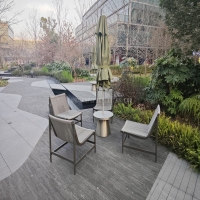Welcome to the website for landscape facilities products and knowledge.
How does the table’s design handle exposure to outdoor educational or workshop settings?
Outdoor educational spaces and workshop settings demand furniture that can withstand unique challenges while supporting learning activities. Modern outdoor table design addresses these requirements through several innovative approaches that balance durability, functionality, and educational needs.
The foundation of any quality outdoor educational table begins with material selection. Manufacturers increasingly utilize powder-coated aluminum, marine-grade polymer, or specially treated wood that resists moisture, UV damage, and temperature fluctuations. These materials prevent warping, fading, and corrosion that would quickly compromise indoor furniture in exterior environments. The best designs incorporate non-porous surfaces that repel water while being easy to clean after messy art projects or science experiments.
Structural engineering plays an equally crucial role in outdoor table performance. Unlike indoor settings where stability is relatively straightforward, outdoor tables must contend with uneven ground and potential high winds. Many manufacturers address this through adjustable legs or weighted bases that maintain stability on grassy areas, gravel, or concrete surfaces. Some designs incorporate anchoring systems for permanent installation in community gardens or outdoor classrooms, while others feature folding mechanisms or wheels for flexible reconfiguration between different workshop activities.
Surface functionality extends beyond mere durability in educational contexts. Designers now integrate measurement markings, built-in ruler edges, or magnetic surfaces that transform ordinary tables into practical teaching tools. These integrated features encourage hands-on learning while eliminating the need for additional equipment that might be damaged by weather exposure. Some manufacturers even incorporate whiteboard surfaces or chalkboard panels directly into the table design, creating instant demonstration areas for outdoor lessons.
Practical considerations for educational settings include safety features and accessibility. Rounded corners prevent injuries during active workshops, while heat-resistant surfaces protect against solar exposure in sunny locations. Many outdoor educational tables now incorporate wheelchair accessibility with appropriate clearance heights and knee spaces, ensuring inclusive learning environments. Cable management systems built into the tables accommodate digital devices and tools used in modern STEM education conducted outdoors.
Maintenance requirements significantly influence table selection for institutional settings. The most successful designs feature minimal maintenance needs through materials that don't require regular painting, sealing, or special treatments. Self-draining channels or slight surface tilting prevent water accumulation after rainfall, while antimicrobial additives in materials inhibit mold and mildew growth in humid climates. These features reduce long-term ownership costs while ensuring tables remain available for daily educational use.
The integration of technology represents the latest evolution in outdoor educational table design. Some manufacturers now include integrated power outlets with weatherproof covers, USB charging ports, and even wireless charging surfaces. These features support the increasing use of tablets, sensors, and digital measuring devices in outdoor learning while maintaining safety through proper weather protection. Cable routing channels keep power cords organized and protected during environmental science experiments or technology workshops.
Ultimately, successful outdoor educational table design transcends mere weather resistance to create multifunctional platforms that actively enhance learning experiences. The most effective solutions combine robust construction with pedagogical considerations, creating spaces where students can engage with nature while having access to practical work surfaces. As educational institutions continue to expand their outdoor learning initiatives, table designs that address these comprehensive needs will become increasingly valuable assets in both formal and informal educational settings.
Related search:

Recommendation
Metal structure rattan chair without armrests for single person, with woven seat and backrest.